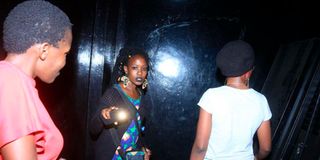Clamour to open up Nyayo House torture chambers

Youth at the Nyayo House Torture Chambers in Nairobi on February 18, 2020. A campaign has been launched to revoke or repeal Legal Notice No. 11 of 1991, which to date lists sections of Nyayo House as protected areas.
What you need to know:
- The former detainees say Legal Notice No. 11 of 1991 remains a stumbling block in the conversion of the former torture chambers to a monument or museum.
On the afternoon of May 21, 1986, Paddy Onyango, a 25-year-old teacher, was taking Form Four students at Ogada Secondary School through CRE lessons on the Exodus of the children of Israel from bondage in Egypt.
Suddenly, armed police officers stormed the classroom and took him away. He was taken to the infamous Nyayo House torture chambers, where he spent the first 14 days standing in a pool of water without being given food. He was detained for 56 days.
Like other Nyayo House detainees, Mr Onyango was accused of engaging in activities as a member of an underground organisation whose intent was to overthrow the government of Daniel arap Moi.
Last Thursday, Mr Onyango joined a team of former detainees and human rights defenders who visited the chambers, where they launched a campaign to revoke or repeal Legal Notice No. 11 of 1991, which to date proscribes sections of Nyayo House as a proscribed protected area.
“It was surreal, everything came flooding back; from the slamming strong room doors to the waterlogged cell I stood in for 14 days without food. It all came back real-time,” Mr Onyango told the Nation.
The former detainees say Legal Notice No. 11 of 1991 remains a stumbling block in the conversion of the former torture chambers to a monument or museum.
Dark past
“We owe it to this and the next generation to memorialise our dark past as a caution against relapsing. Our generation is fast fading away hence the need to transfer the memory to generation now and next. It is a sacred duty,” Mr Onyango said.
Although the chambers were first exposed to the public in February 2003, efforts to have them opened to the public have not borne fruit. To date, to get access to the chambers, you need to secure permission from the county commissioner and the director general of the National Intelligence Service.
Two days before the visit to the torture chambers, on February 16, Wachira Waheire, a former detainee, wrote a letter on behalf of his fellow detainees to Interior CS Fred Matiang’i urging him to revoke the notice.
“As you are probably aware, the former torture chambers at the Nyayo House building in Nairobi is yet to be converted into a national monument since a pronunciation by government was made in 2003. The place still remains inaccessible to the survivors, families, friends, relatives and Kenyans in general,” the letter reads in part.
“This is also despite a declaration by the then Prime Minister Raila Odinga while touring the facility in 2010 and the recommendations made in the report of the Truth, Justice and Reconciliation Commission (TJRC) regarding the conversion of the former torture chambers into a monument in 2013. The recommendations of the TJRC have now been gazetted by government.” The Legal Notice Number 11 was issued by former Minister for State Jackson Angaine on February 1, 1991, quoting The Protected Areas (Amendment) Order, 1991.
“The order was actually a belated attempt at justifying and shielding the illegal detention and torture of many innocent Kenyans at the time,” Mr Waheire’s letter reads.
Detained
“We are therefore appealing to you to utilise your good office to have the said Legal Notice No 11 of 1991 repealed so that you can pave the way for the establishment of a memorial site/museum for remembrance and learning of our country’s past at the former Nyayo House torture facility.”
Victims of Nyayo House Torture chambers underwent different ordeals. There were those who were tortured, taken to court at night and handed sentences ranging from four to 16 years.
Others were killed while some were detained for short stints of between seven to 14 days.
There were also senior citizens who were detained without trial.
At least 107 individuals were arrested, charged, convicted and jailed. Another 32 victims were arrested, confined, tortured, jailed and died during detention or almost immediately after release. Thirteen survivors were detained without trial while 58 were released without any charge, according to the book We Lived to Tell The Nyayo House Story.
The conversion of the chambers to a monument or museum is among the historical injustices yet to be fully addressed.
In his State of the Nation address of 2015, President Kenyatta acknowledged the commission of human rights violations in the past and issued a public apology.
To offer redress for historical injustices, the President ordered for the establishment of a Sh10 billion Restorative Fund, which he further reiterated in his 2019 State of the Nation address.
These proclamations are yet to be effected.





